Automotive Voice Recognition System Market Size

| Study Period | 2019 - 2029 |
| Market Size (2024) | USD 3.06 Billion |
| Market Size (2029) | USD 6.09 Billion |
| CAGR (2024 - 2029) | 14.77 % |
| Fastest Growing Market | Asia Pacific |
| Largest Market | North America |
| Market Concentration | Medium |
Major Players
*Disclaimer: Major Players sorted in no particular order |
Automotive Voice Recognition System Market Analysis
The Automotive Voice Recognition System Market size is estimated at USD 3.06 billion in 2024, and is expected to reach USD 6.09 billion by 2029, growing at a CAGR of 14.77% during the forecast period (2024-2029).
Over the forecast period, the market is expected to be driven by several factors, including increasing automobile production and sales, higher income levels of consumers in most parts of the world, enabling them to spend more on comfort and luxury services, development of infotainment and technology services to provide safety and comfort to the driver as well as the growing preference of young customers for automobiles equipped with the latest connectivity and AI features.
• According to the International Organization of Motor Vehicle Manufacturers (OICA), new light commercial vehicle sales touched 19.8 million units in 2022 compared to 18.6 million units in 2021 worldwide, recording a substantial Y-o-Y growth of 7%.
Moreover, rapid enhancement in autonomous vehicles and connected vehicle technology will fuel the demand for advanced automotive voice recognition systems as they assist in providing a hands-free experience to drivers. Coupled with that, the increasing penetration of electric vehicles worldwide is also a major contributor to the rising demand for automotive voice recognition systems.
• According to the International Energy Agency (IEA), battery electric vehicle sales worldwide touched 7.3 million units in 2022 compared to 4.6 million units in 2021, representing a Y-o-Y growth of 58.6%.
Key players in the market are expanding their services by tying up with major automobile original equipment manufacturers (OEMs) to integrate their voice recognition technologies into OEMs' vehicles. For instance,
• In August 2023, SoundHound AI Inc. launched its advanced AI technology, including innovative Edge+Cloud connectivity, multiple language capabilities, and a custom-branded voice assistant to be integrated into a new line of smart vehicles from Turkish mobility provider Togg. Further, the company stated that Togg’s in-vehicle AI-powered voice assistant can track and understand speech context in real-time (in instances even before the user has finished speaking). Using SoundHound’s proprietary Speech-to-Meaning® and Deep Meaning Understanding® technologies, it can also address multiple questions and filter results.
• In September 2022, BMW Group announced that it had selected Cerence Inc., a Microsoft Corp. subsidiary, for developing a new voice and AI-powered voice assistant for integration into the latest version of BMW Intelligent Personal Assistant (IPA). These features would be available in the new BMW 7 Series and BMW i7.
Asia-Pacific is expected to become the fastest-growing regional market due to large sales of connected vehicles, young automobile buyers' willingness to opt for the latest connectivity features like voice recognition technology, and a large presence of automakers. Europe and North America are the next largest markets because of the close affinity of car buyers to new-age technologies like voice recognition and high sales of connected vehicles.
Automotive Voice Recognition System Market Trends
Passenger Cars Segment to Gain Traction During the Forecast Period
Customers increasingly prefer to purchase a car with advanced connectivity features rather than the mechanical specifications of the vehicle because they demand driving comfort and convenience more than the outright power or torque figures. This trend is increasingly observed in major automotive markets worldwide, which has led to an increase in the demand for features like in-vehicle voice recognition systems.
- According to the International Organization of Motor Vehicle Manufacturers (OICA), new passenger vehicle sales worldwide touched 57.4 million units in 2022 compared to 56.4 million units in 2021, representing a Y-o-Y growth of 1.9%.
Further, the demand for voice recognition systems is being accelerated by the rising sales of connected cars and autonomous vehicles. Both connected as well as autonomous vehicles have voice recognition technology as a standard feature. Voice recognition systems have been seen to reduce the number of vehicle accidents since they free drivers from basic, routine tasks so they can fully concentrate on driving. Luxury and premium passenger cars offered by various automakers, such as Mercedes, BMW, and Audi, are rapidly integrating advanced voice recognition systems in their vehicles to gain a competitive edge in the industry, which, in turn, is positively impacting the surging demand for this segment of the market.
- In 2022, BMW, Mercedes-Benz, and Audi were the leading automakers with the highest luxury vehicle sales worldwide. BMW registered sales of 2.4 million units of luxury vehicles, followed by 2.07 million units by Mercedes-Benz and a sales volume of 1.61 million units by Audi in 2022.
Thus, increasing sales of connected and autonomous vehicles, the trend toward greater vehicle safety, and the availability of voice recognition systems in mid-priced vehicles like family sedans and compact SUVs are some of the factors anticipated to drive the market in the forecast period.

Asia-Pacific Expected to be the Fastest-growing Regional Market During the Forecast Period
The Asia-Pacific is expected to be the fastest-growing regional market, followed by North America and Europe. Asia-Pacific is a huge market for passenger vehicles. India and China are some of the largest markets for passenger vehicles in the world, contributing to almost 30% of the global passenger vehicle sales, thus making Asia-Pacific the most lucrative regional market for automotive voice recognition systems.
- According to the Society of Manufacturers of Electric Vehicles, electric four-wheeler sales touched 48,105 units in FY 2023 compared to 19,782 units in FY 2022, representing a Y-o-Y growth of 143.1%.
- According to the Japan Automobile Dealers Association, in October 2023, the new vehicle market in Japan made a strong recovery, with sales rising by 10.7% to 397,672 units from 359,159 units in October 2022.
Major auto manufacturers in Asia-Pacific countries are increasingly preferring to integrate advanced solutions in their vehicles to enhance customers' convenience. The incorporation of artificial intelligence and virtual assistant-enabled voice recognition systems in their vehicle fleets is among the innovative technological features that these players are relying on. Major automakers are forming long-term partnerships with voice recognition system suppliers and are investing hefty sums in the development of advanced voice recognition systems that can cater to the increasing demand. For instance,
- In November 2023, Renault Korea Motors announced that it had signed a memorandum of understanding (MOU) with Tmap Mobility Co. for future infotainment collaboration. As part of the new car development project "Aurora Project," Renault Korea plans to equip the mid-size hybrid sports utility vehicle (SUV) with "Tmap Infotainment," which is capable of providing in-car voice recognition "NUGU Auto," Tmap Store, in-car easy payment, and electric vehicle-specialized services.
- In April 2023, Cerence Inc. announced that Chinese smart car supplier Banma had tapped Cerence to bring advanced in-car conversational AI and voice recognition technology to Banma’s automaker customers, including Shanghai Volkswagen Automotive Co. (SVW) and FAW-Volkswagen (FAW-VW). Cerence’s flagship conversational AI enables in-car assistants to function as proactive, trusted co-pilots, leading drivers through their daily journeys while staying safe, informed, and comfortable.
Thus, with rapid advancements and innovations in this segment, the market for automotive voice recognition systems is expected to grow over the forecast period for both the commercial and passenger vehicles segment across Asia-Pacific countries.

Automotive Voice Recognition System Industry Overview
The automotive voice recognition system market is fragmented and highly competitive due to various incumbent players and new entrants operating in the ecosystem. The market is characterized by the presence of considerably large players who have entered into collaborations with major auto manufacturers. These players also engage in joint ventures, mergers and acquisitions, new product launches, and product development to expand their brand portfolios and cement their market positions. For instance,
- In January 2024, Volkswagen announced that starting in spring 2024, the Cerence Chat Pro systems that are part of the infotainment in the VW 1D3, ID4, ID5, ID7, Tiguan, Passat, and Golf would integrate ChatGPT to assist with parsing voice requests and enabling a variety of functions. This includes controlling the infotainment, navigation, and climate functions.
- In June 2023, MG Motor India, the Indian unit of British car maker Morris Garages, announced its partnership with Jio Platforms to offer unique voice solutions as part of its connected car features in its newly launched smart electric vehicle in India. As per the agreement, Jio's Hinglish voice assistant system, HelloJio, will offer versatile in-car voice assistants to Indian users driving the Comet EV.
- In July 2022, LG Electronics Inc. collaborated with SoundHound AI Inc. to incorporate SoundHound's advanced AI-based voice recognition platform into LG's IVI infotainment systems for automobiles. The partnership will enable LG Electronics Inc. to offer SoundHound Inc.'s advanced voice-based AI that offers conversational voice controls to ensure a very high degree of convenience for drivers and passengers of the vehicle.
The market is anticipated to witness the integration of advanced technologies such as artificial intelligence and virtual assistants like Alexa in automotive voice recognition systems over the coming years.
Automotive Voice Recognition System Market Leaders
-
Microsoft Corporation
-
Apple Inc.
-
Alphabet Inc.
-
SoundHound AI Inc.
-
Amazon.com, Inc.
*Disclaimer: Major Players sorted in no particular order

Automotive Voice Recognition System Market News
- January 2024: Cerence announced its collaboration with Microsoft to enhance in-car experiences by integrating Microsoft Azure AI Services, including OpenAI’s ChatGPT. This partnership aims to revolutionize voice and touch user interfaces in vehicles by combining Cerence’s automotive expertise with Microsoft’s advanced AI capabilities. The initial focus is on incorporating the ChatGPT model through Azure into Cerence’s in-car assistant platform, Cerence Assistant, to enhance post-purchase value and user experience.
- October 2023: Lexus introduced its new concept battery electric car, Lexus Future Zero-emission Catalyst, at the Japan Mobility Show 2023, which is equipped with a voice recognition system that employs advanced artificial intelligence technology so it can talk, act, and reply like a personal butler. Further, the company stated that the automated voice learns from the driver’s habits to predict what they want to happen the next time they drive. As soon as it picks up on the drivers' routines and the apps and car functionality they typically use, Butler will activate them without needing to ask them.
- June 2023: Mercedes-Benz announced that the drivers in the United States will be able to power some of their luxury vehicles with ChatGPT in a three-month test program, which is compatible with 900,000 vehicles with the automaker's "MBUX" voice recognition system. The ChatGPT feature can be downloaded over the air after drivers opt-in via a Mercedes app or by voice command.
- September 2022: Cerence Inc. and Microsoft Corp. collaborated to enable access to all Microsoft's tools, including Microsoft Teams, using Cerence's voice recognition technologies in the vehicles. Both companies will jointly promote this new solution to automobile OEMs looking to offer the latest voice recognition technologies in their upcoming vehicles.
Automotive Voice Recognition System Market Report - Table of Contents
1. INTRODUCTION
1.1 Study Assumptions
1.2 Scope of the Study
2. RESEARCH METHODOLOGY
3. EXECUTIVE SUMMARY
4. MARKET DYNAMICS
4.1 Market Drivers
4.1.1 Increasing Demand for Luxury and Premium Passenger Cars to Foster Market Growth
4.2 Market Restraints
4.2.1 High Purchase and Installation Costs Deter Market Growth
4.3 Industry Attractiveness - Porter's Five Forces' Analysis
4.3.1 Threat of New Entrants
4.3.2 Bargaining Power of Buyers/Consumers
4.3.3 Bargaining Power of Suppliers
4.3.4 Threat of Substitute Products
4.3.5 Intensity of Competitive Rivalry
5. MARKET SEGMENTATION (Market Size in Value - USD)
5.1 By Vehicle Type
5.1.1 Passenger Cars
5.1.2 Commercial Vehicles
5.2 By Technology
5.2.1 Embedded
5.2.2 Cloud-based
5.2.3 Hybrid
5.3 By Vehicle Class
5.3.1 Economy
5.3.2 Mid-priced
5.3.3 Luxury
5.4 By Geography
5.4.1 North America
5.4.1.1 United States
5.4.1.2 Canada
5.4.1.3 Rest of North America
5.4.2 Europe
5.4.2.1 Germany
5.4.2.2 United Kingdom
5.4.2.3 France
5.4.2.4 Italy
5.4.2.5 Rest of Europe
5.4.3 Asia-Pacific
5.4.3.1 China
5.4.3.2 India
5.4.3.3 Japan
5.4.3.4 South Korea
5.4.3.5 Rest of Asia-Pacific
5.4.4 Rest of the World
5.4.4.1 South America
5.4.4.2 Middle East and Africa
6. COMPETITIVE LANDSCAPE
6.1 Vendor Market Share
6.2 Company Profiles*
6.2.1 Microsoft Corporation
6.2.2 Apple Inc.
6.2.3 Alphabet Inc.
6.2.4 Harman International Industries
6.2.5 Nuance Communications Inc.
6.2.6 Sensory Inc.
6.2.7 IBM Corporation
6.2.8 SoundHound AI Inc.
6.2.9 Kardome Technology Ltd
6.2.10 Amazon.com Inc.
6.2.11 Robert Bosch GmbH
6.2.12 iNago Corporation
7. MARKET OPPORTUNITIES AND FUTURE TRENDS
7.1 Integration of Advanced Technologies such as Artificial Intelligence (AI) and Virtual Assistants into Voice Recognition Systems Propel Market Demand
Automotive Voice Recognition System Industry Segmentation
Automotive voice recognition systems are computer programs and hardware devices used in an automobile to decode the human voice in order to offer a hands-free communication experience to avoid or minimize the driver's distraction while driving the vehicle in the interest of enhanced safety.
The automotive voice recognition system market is segmented by vehicle type, technology, vehicle class, and geography. By vehicle type, the market is segmented into passenger cars and commercial vehicles. By technology, the market is segmented into embedded, cloud-based, and hybrid. By vehicle class, the market is segmented into economy, mid-priced, and luxury. By geography, the market is segmented into North America, Europe, Asia-Pacific, and Rest of the World.
The report offers size and forecasts for the automotive voice recognition system market in value (USD) for all the above segments.
| By Vehicle Type | |
| Passenger Cars | |
| Commercial Vehicles |
| By Technology | |
| Embedded | |
| Cloud-based | |
| Hybrid |
| By Vehicle Class | |
| Economy | |
| Mid-priced | |
| Luxury |
| By Geography | |||||||
| |||||||
| |||||||
| |||||||
|
Automotive Voice Recognition System Market Research FAQs
How big is the Automotive Voice Recognition System Market?
The Automotive Voice Recognition System Market size is expected to reach USD 3.06 billion in 2024 and grow at a CAGR of 14.77% to reach USD 6.09 billion by 2029.
What is the current Automotive Voice Recognition System Market size?
In 2024, the Automotive Voice Recognition System Market size is expected to reach USD 3.06 billion.
Who are the key players in Automotive Voice Recognition System Market?
Microsoft Corporation, Apple Inc., Alphabet Inc., SoundHound AI Inc. and Amazon.com, Inc. are the major companies operating in the Automotive Voice Recognition System Market.
Which is the fastest growing region in Automotive Voice Recognition System Market?
Asia Pacific is estimated to grow at the highest CAGR over the forecast period (2024-2029).
Which region has the biggest share in Automotive Voice Recognition System Market?
In 2024, the North America accounts for the largest market share in Automotive Voice Recognition System Market.
What years does this Automotive Voice Recognition System Market cover, and what was the market size in 2023?
In 2023, the Automotive Voice Recognition System Market size was estimated at USD 2.61 billion. The report covers the Automotive Voice Recognition System Market historical market size for years: 2019, 2020, 2021, 2022 and 2023. The report also forecasts the Automotive Voice Recognition System Market size for years: 2024, 2025, 2026, 2027, 2028 and 2029.
Automotive Voice Recognition System Industry Report
Statistics for the 2024 Automotive Voice Recognition System market share, size and revenue growth rate, created by Mordor Intelligence™ Industry Reports. Automotive Voice Recognition System analysis includes a market forecast outlook to 2029 and historical overview. Get a sample of this industry analysis as a free report PDF download.



